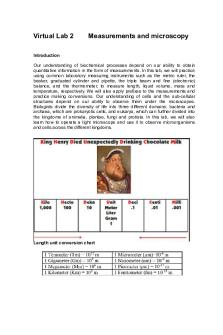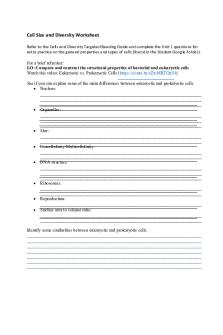2 Cell Staining and Microscopy worksheet PDF

| Title | 2 Cell Staining and Microscopy worksheet |
|---|---|
| Author | Cody Rogers |
| Course | General Biology II - Lab |
| Institution | Grand Canyon University |
| Pages | 5 |
| File Size | 238.1 KB |
| File Type | |
| Total Downloads | 103 |
| Total Views | 149 |
Summary
Download 2 Cell Staining and Microscopy worksheet PDF
Description
Name: Cody Rogers
Cell Staining and Microscopy Lab Worksheet Size Estimation Directions: Complete Table 1 to determine the field of view (FOV) for each objective lens (10X, 40X, and 100X). Table 1
Estimation of Magnification Power of a Compound Microscope Power of Lens
Magnification
FOV Diameter (mm)
Diameter (µm)
FOV Area (mm2)
4X
40X
4.5
4500
15.9
10X
100X
1.8
1800
2.5
40X
400X
0.45
450
.16
100X
1000X
0.18
180
.03
Observation of Prepared Specimens Directions 1. Observe the indicated specimen (paramecium, volvox, and ameoba) at the optimal magnification. Optimal magnification is the magnification that allows the entire organism to be seen in the greatest detail. 2. Note the lens of observation and the total magnification. 3. Using the information from Table 1, estimate the size of the specimen at this magnification.
Specimen: Paramecium Lens of observation: 40X Total magnification: 400X Estimated size of Paramecium: 225mm^2 (Remember to include the units of metric measure) Sketch the organism that was observed under the microscope.
1
Name:
Cell Staining and Microscopy Lab Worksheet Specimen: Volvox Lens of observation: 40X Total magnification: 400X Estimated size of Volvox: 450mm^2 (Remember to include the units of metric measure) Sketch the organism that was observed under the microscope.
Name:
Cell Staining and Microscopy Lab Worksheet Specimen: Amoeba Lens of observation: 40X Total magnification: 400X Estimated size of Amoeba: 112.5^2 (Remember to include the units of metric measure) Sketch the organism that was observed under the microscope.
Review Questions Answer each question using full sentences. 1. Paramecium was found to occupy 20% of the FOV of a microscope at 40X magnification power. How many paramecia can be accommodated within this FOV? Since Paramecium occupys 20% of the FOV at 40X magnification, the amount of paramecia that can be accommodated within the FOV would be 5 because 20*5 is 100.
2. If 300 Amoeba can be contained within a 50 mm2 area of the FOV of the microscope, what would the approximate size of each parasite be? (Note: A=πr^2)
0.167mm^2 is the size of each Amoeba
3. Plasmodium was found to occupy 2% of the FOV of a microscope with 100 mm diameter. What would the size of the parasite be? How many parasites can be accommodated within this FOV? .2 x 150 = 2mm^2 50 plasmodium will fit within the FOV and the size of the parasite is 2mm^2 which is .2 x 150
4. A worm is 2 mm in size and occupies 60% of the FOV. What is the diameter of the FOV at this unknown magnification? 2/6 = 3.33mm^2 2= 0.6d/0.6 the diameter of the unknown magnification is 3.33mm^2
5. What is the diameter of a FOV at an unknown magnification if the size of a flea is 2 mm, and it occupies 30% of the FOV? 2/0.30 = 6.67mm The diameter of the FOV is 6.67mm
6. If the diameter of the FOV of a compound microscope at 40X magnification is 450 micrometers (µm), what would be the FOV at 400X magnification? 450µm * 10 = 4500µm The FOV at 400X magnification would be 4500µm
7. A parasite occupies 30% of the FOV in a microscope under 400X total magnification. At this magnification, the FOV of the microscope is 200 µm. What is the size of the parasite? The FOV at 400X magnification is 200µm. You then divide 200µm by 400, which gives you 0.5µm. To get the area of the FOV you do 0.5µm x 0.5µm which equals 0.25 µm^2 Then to get 30% of the area that the parasite takes you do 0.25 µm^2 x 0.3 which is 0.075 µm^2 To find the radius you do r = √(0.075/π) The radius of the parasite is r = 0.15 µm...
Similar Free PDFs

PSB Microscopy Worksheet
- 5 Pages

Worksheet Mitosis And Cell Cycle
- 2 Pages

Microscopy - Lecture notes 2
- 3 Pages

microscopy workshop 2 analysis
- 14 Pages

Staining MELS
- 4 Pages

Cell Anatomy Worksheet
- 3 Pages

Cell Membrane Coloring Worksheet
- 2 Pages

- Cell Energy worksheet
- 6 Pages
Popular Institutions
- Tinajero National High School - Annex
- Politeknik Caltex Riau
- Yokohama City University
- SGT University
- University of Al-Qadisiyah
- Divine Word College of Vigan
- Techniek College Rotterdam
- Universidade de Santiago
- Universiti Teknologi MARA Cawangan Johor Kampus Pasir Gudang
- Poltekkes Kemenkes Yogyakarta
- Baguio City National High School
- Colegio san marcos
- preparatoria uno
- Centro de Bachillerato Tecnológico Industrial y de Servicios No. 107
- Dalian Maritime University
- Quang Trung Secondary School
- Colegio Tecnológico en Informática
- Corporación Regional de Educación Superior
- Grupo CEDVA
- Dar Al Uloom University
- Centro de Estudios Preuniversitarios de la Universidad Nacional de Ingeniería
- 上智大学
- Aakash International School, Nuna Majara
- San Felipe Neri Catholic School
- Kang Chiao International School - New Taipei City
- Misamis Occidental National High School
- Institución Educativa Escuela Normal Juan Ladrilleros
- Kolehiyo ng Pantukan
- Batanes State College
- Instituto Continental
- Sekolah Menengah Kejuruan Kesehatan Kaltara (Tarakan)
- Colegio de La Inmaculada Concepcion - Cebu







